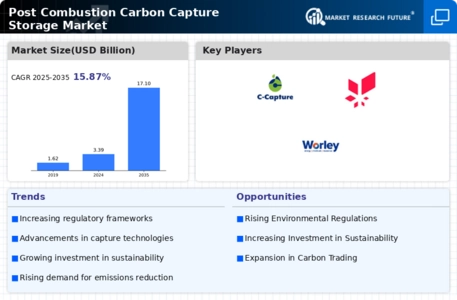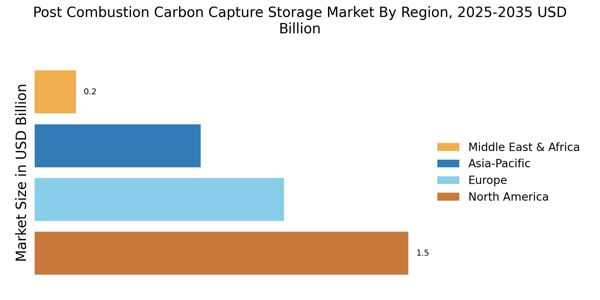Rising Energy Demand
The Post Combustion Carbon Capture Storage Market is also influenced by the increasing global energy demand. As populations grow and economies develop, the need for energy continues to rise, leading to higher carbon emissions from fossil fuel-based power generation. This scenario creates a pressing need for effective carbon capture solutions to mitigate environmental impacts. The International Energy Agency has reported that energy-related CO2 emissions are expected to rise, necessitating the adoption of carbon capture technologies. Consequently, the post combustion carbon capture market is poised for growth as energy producers seek to balance energy supply with environmental responsibility, potentially leading to a market expansion of 20% by 2030.
Technological Innovations
Technological advancements play a crucial role in shaping the Post Combustion Carbon Capture Storage Market. Innovations in capture technologies, such as solvent-based systems and membrane separation, are enhancing the efficiency and cost-effectiveness of carbon capture processes. These advancements not only improve the viability of carbon capture but also reduce operational costs, making it more attractive for industries to invest in these solutions. Furthermore, research and development initiatives are likely to yield new methods that could further lower the energy requirements for carbon capture. As these technologies mature, they are expected to drive market growth, with estimates suggesting a potential increase in market size by 25% over the next decade.
Corporate Sustainability Initiatives
The Post Combustion Carbon Capture Storage Market is increasingly influenced by corporate sustainability initiatives. Many companies are setting ambitious targets to achieve net-zero emissions, prompting them to invest in carbon capture technologies as part of their sustainability strategies. This trend is particularly evident in sectors such as oil and gas, cement, and steel, where emissions are substantial. By integrating carbon capture solutions, these companies not only comply with regulations but also enhance their brand reputation and appeal to environmentally conscious consumers. As more corporations commit to sustainability, the demand for post combustion carbon capture technologies is expected to rise, potentially leading to a market growth of 30% by 2025.
Increasing Environmental Regulations
The Post Combustion Carbon Capture Storage Market is experiencing a surge in demand due to stringent environmental regulations aimed at reducing greenhouse gas emissions. Governments across various regions are implementing policies that mandate lower carbon footprints for industrial operations. For instance, regulations such as carbon pricing and emissions trading schemes are compelling industries to adopt carbon capture technologies. This regulatory landscape not only drives investment in carbon capture solutions but also encourages innovation in the sector. As industries strive to comply with these regulations, the market for post combustion carbon capture technologies is likely to expand significantly, with projections indicating a potential market growth rate of over 15% annually in the coming years.
Investment in Carbon Management Solutions
Investment in carbon management solutions is a significant driver for the Post Combustion Carbon Capture Storage Market. As awareness of climate change intensifies, both public and private sectors are channeling funds into carbon capture projects. Financial institutions are increasingly recognizing the potential of carbon capture technologies as viable investment opportunities, leading to a surge in funding for research, development, and deployment of these solutions. This influx of capital is likely to accelerate the commercialization of innovative carbon capture technologies, thereby expanding the market. Projections indicate that investment in carbon management could reach billions of dollars in the next few years, further propelling the growth of the post combustion carbon capture market.


















Leave a Comment